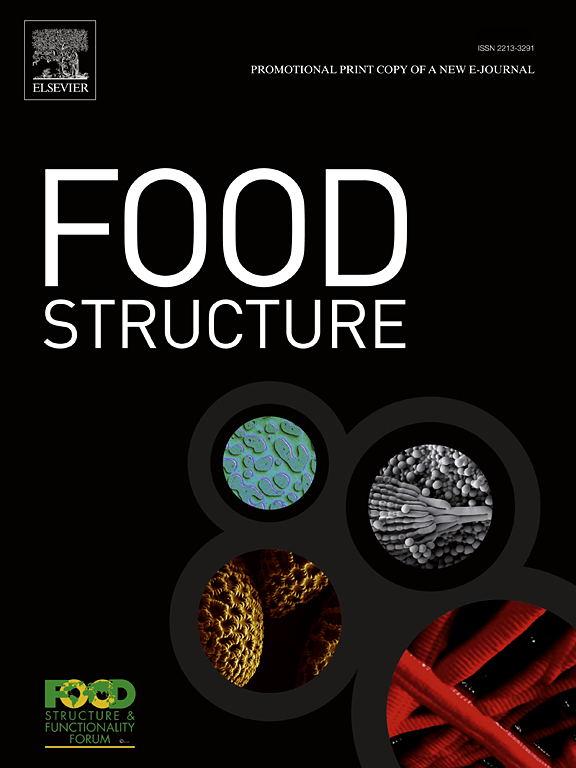Preparation of soy protein-based meat analogs by freeze alignment technique: Experimental and modeling of ice crystal size control
IF 5.9
3区 农林科学
Q1 FOOD SCIENCE & TECHNOLOGY
引用次数: 0
Abstract
This study investigates the application of a freeze alignment technique to control ice crystal formation in soy protein-based meat analogs, a critical factor influencing the texture of the final product. Varying the freezing methods (air blast and plate freezing) and temperatures from −10 °C to −80 °C, resulted in various freezing rates and directions, which in turn affected the patterns of ice crystal formation. Ice crystal sizes (L*) were obtained experimentally, and the freezing front rate (R) and temperature gradient (G) were obtained from simulation results using the finite element method. The empirical equation, L* = 201.77 R−0.03 G−0.30, was validated against experimental data, with an overall prediction error of 14.74 %. The developed empirical equation serves as a general model for predicting ice crystal size across various freezing methods and temperatures. The results demonstrate that lower freezing temperatures and higher freezing rates produced smaller ice crystals, with average sizes ranging from 77 µm to 209 µm. The developed prediction model, supported by both experimental and simulation data, offers a valuable tool for optimizing the freezing process in the production of soy protein-based meat analogs. The results of this study emphasize the importance of controlling the freezing parameters, especially the temperature gradient, to achieve the desired microstructure in meat analogs produced via the freeze-alignment technique. This predictive equation is a key contribution to designing the textual characteristics of plant-based meat analogs.
用冷冻对准技术制备大豆蛋白基肉类类似物:冰晶大小控制的实验和建模
本研究研究了冷冻比对技术的应用,以控制大豆蛋白基肉类类似物中冰晶的形成,这是影响最终产品质地的关键因素。不同的冷冻方法(吹风和平板冷冻)和温度从- 10°C到- 80°C,导致不同的冷冻速率和方向,这反过来影响了冰晶形成的模式。实验得到冰晶尺寸(L*),有限元模拟得到冻结锋速率(R)和温度梯度(G)。根据实验数据对经验方程L* = 201.77 R−0.03 G−0.30进行验证,总体预测误差为14.74 %。所开发的经验方程可作为预测各种冻结方法和温度下冰晶大小的一般模型。结果表明,较低的冻结温度和较高的冻结速率产生的冰晶较小,平均尺寸在77 µm到209 µm之间。该预测模型得到了实验和模拟数据的支持,为优化大豆蛋白基肉类类似物生产中的冷冻过程提供了有价值的工具。本研究的结果强调了控制冷冻参数的重要性,特别是温度梯度,以实现通过冷冻校准技术生产的肉类类似物所需的微观结构。这个预测方程是设计植物性肉类类似物文本特征的关键贡献。
本文章由计算机程序翻译,如有差异,请以英文原文为准。
求助全文
约1分钟内获得全文
求助全文
来源期刊

Food Structure-Netherlands
Chemical Engineering-Bioengineering
CiteScore
7.20
自引率
0.00%
发文量
48
期刊介绍:
Food Structure is the premier international forum devoted to the publication of high-quality original research on food structure. The focus of this journal is on food structure in the context of its relationship with molecular composition, processing and macroscopic properties (e.g., shelf stability, sensory properties, etc.). Manuscripts that only report qualitative findings and micrographs and that lack sound hypothesis-driven, quantitative structure-function research are not accepted. Significance of the research findings for the food science community and/or industry must also be highlighted.
 求助内容:
求助内容: 应助结果提醒方式:
应助结果提醒方式:


